Abstract
1. The endothelium-dependent relaxation of blood vessels induced by P2Y-purinoceptor activation has often been shown to involve prostacyclin and/or nitric oxide (NO) release. In this work, we have investigated the mechanisms involved in the relaxant effect of the P2Y agonist, adenosine -5'-O-(2-thiodiphosphate) (ADP beta S) using two complementary preparations: rat pancreatic vascular bed and aortic ring. 2. On the pancreatic vascular bed, ADP beta S (1.5 and 15 microM) infused for 30 min induced a concentration-dependent vasodilatation; it was progressive during the first 10 min (first period) and sustained from 10 to 30 min (second period). Indomethacin (10 microM) delayed ADP beta S-induced vasodilatation (1.5 and 15 microM) by about 6 min. N omega-nitro-L-arginine methyl ester (L-NAME) (200 microM) suppressed the relaxation for about 5 min but thereafter ADP beta S at the two concentrations progressively induced an increase in the flow rate. Even the co-administration of L-NAME and indomethacin did not abolish the ADP beta S-induced vasorelaxation. 3. On 5-hydroxy tryptamine (5-HT) precontracted rings mounted in isometric conditions in organ baths, we observed that ADP beta S induced a concentration-dependent relaxation of rings with a functional endothelium; this effect was stable for 25 min. The ADP beta S relaxant effect was strongly inhibited by Reactive Blue 2 (30 microM) and was suppressed by pretreatment of rings with saponin (0.05 mg ml-1 for 30 min), which also abolished the acetylcholine-induced relaxation. 4. ADP beta S-induced relaxation of 5-HT precontracted rings is largely inhibited by indomethacin (100 or 10 microM) or L-NAME (100 microM). 5. We conclude that: the ADP beta S-induced relaxation is endothelium-dependent, mediated by P2Y-purinoceptors, and at least in part linked to NO and prostacyclin release, depending on the preparation used. Furthermore, on the pancreatic vascular bed, (an)other mechanism(s) than prostacyclin and NO releases may be involved in ADP beta S-induced vasodilatation.
Full text
PDF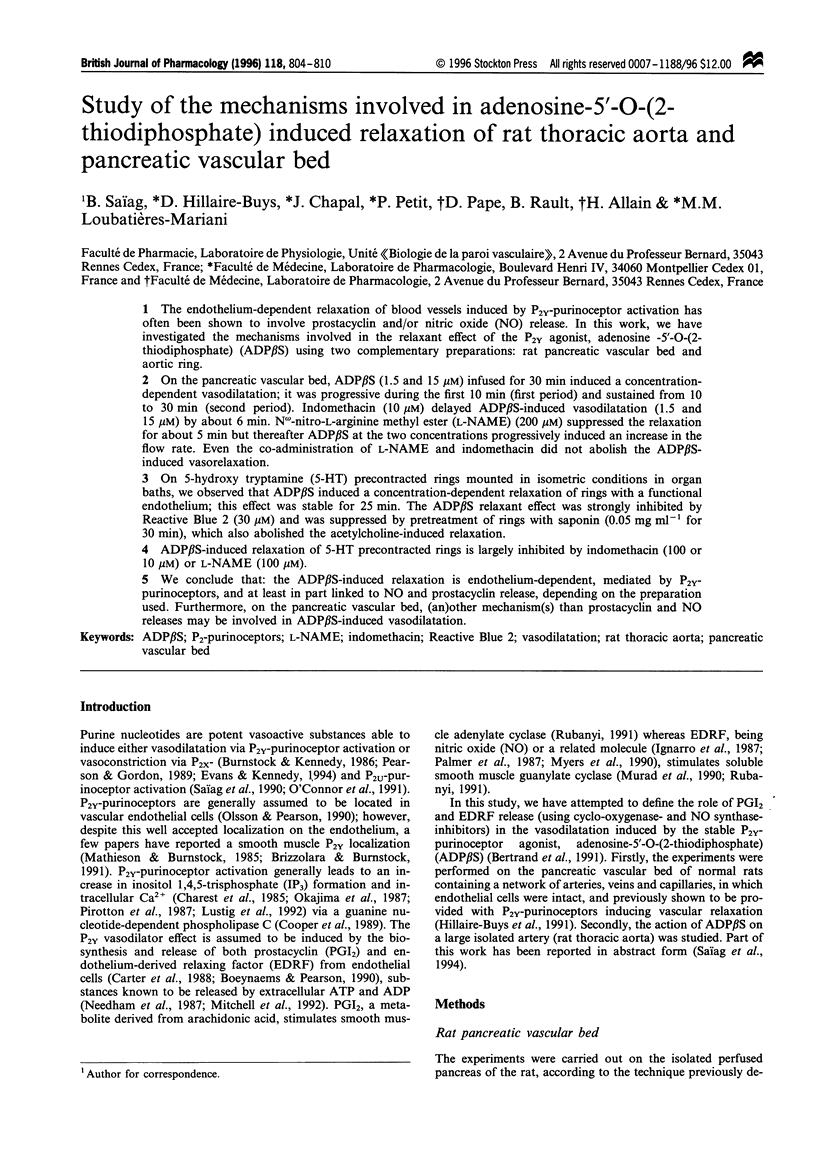
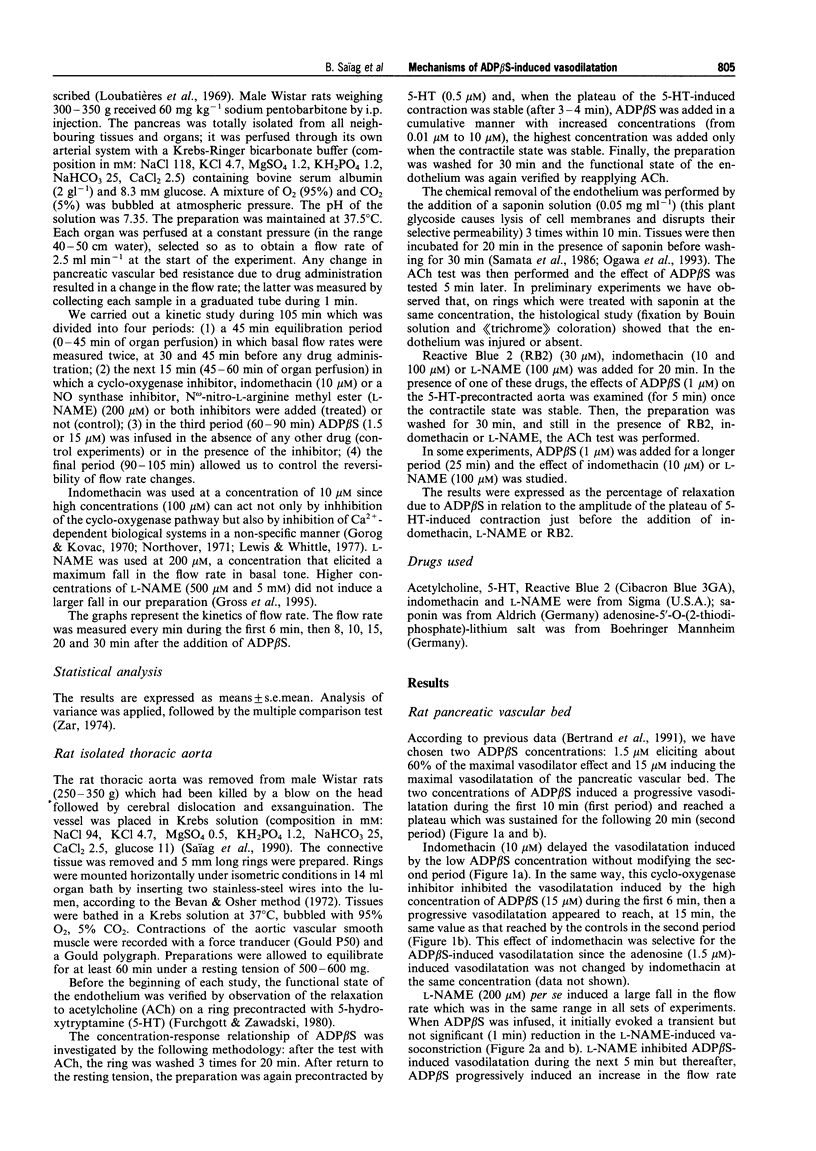
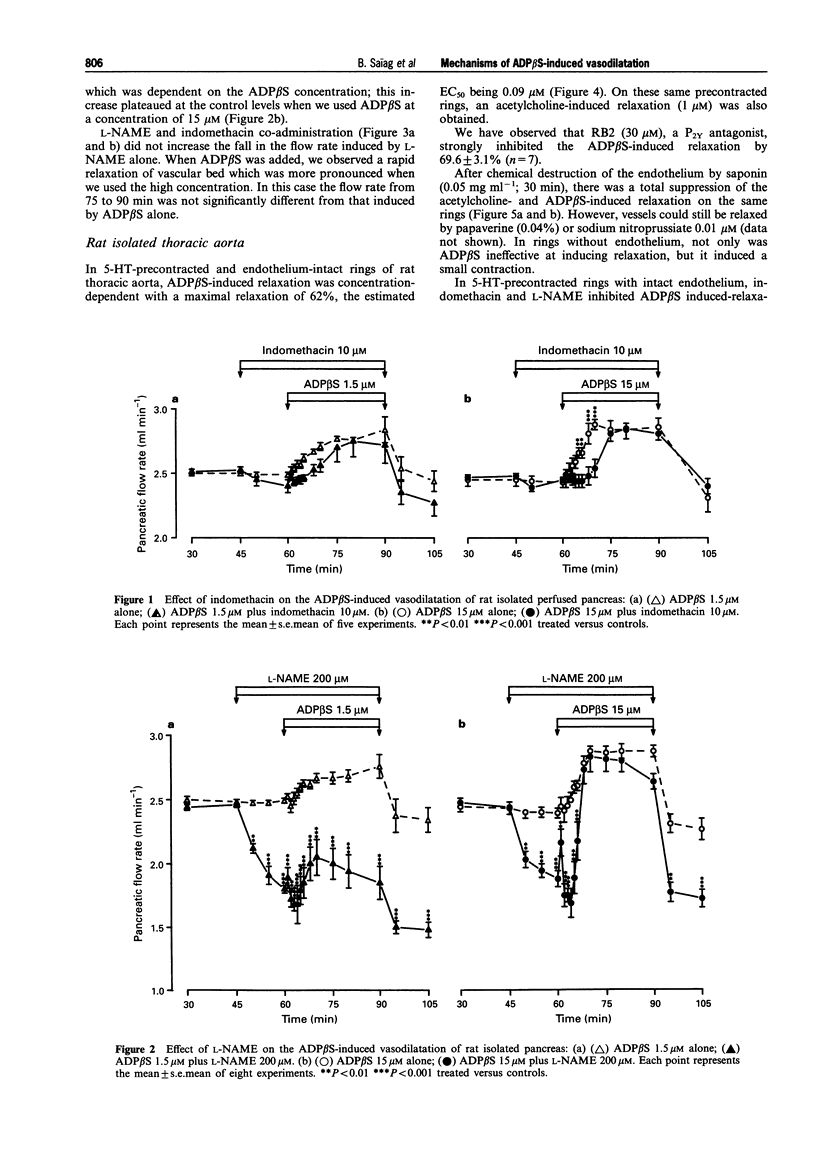
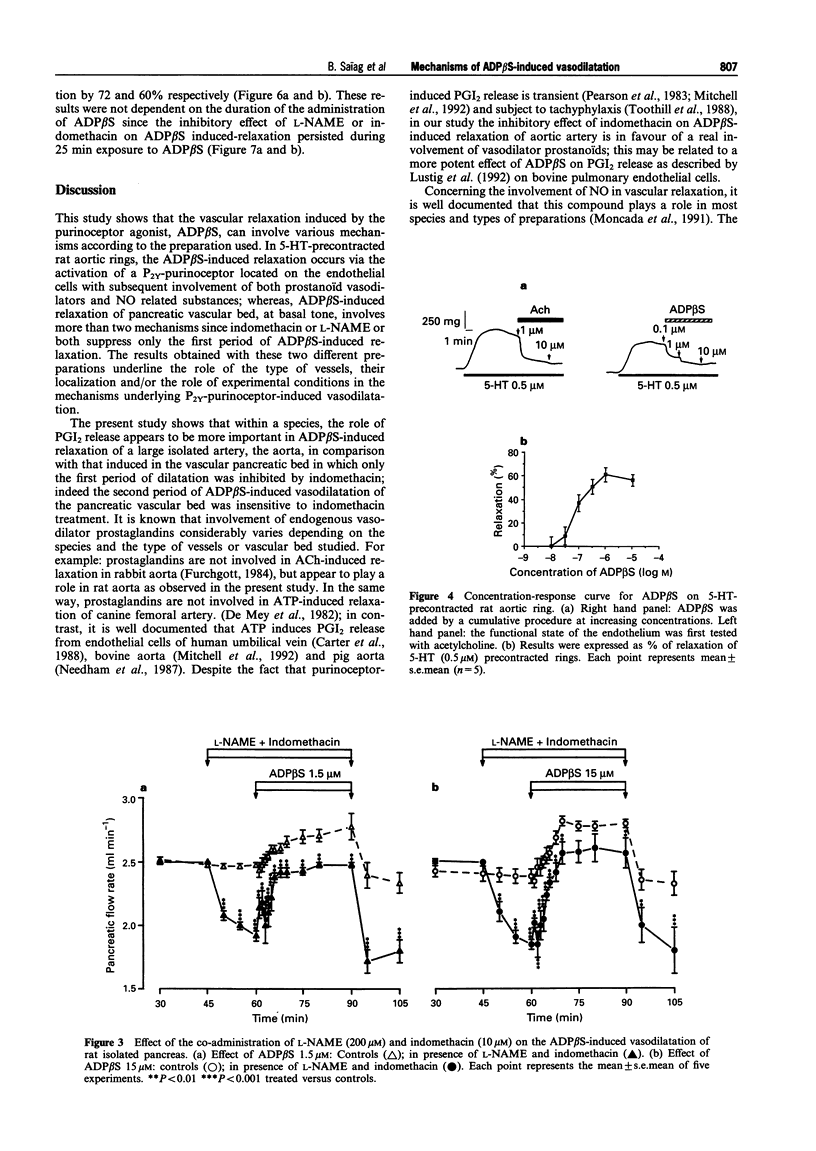
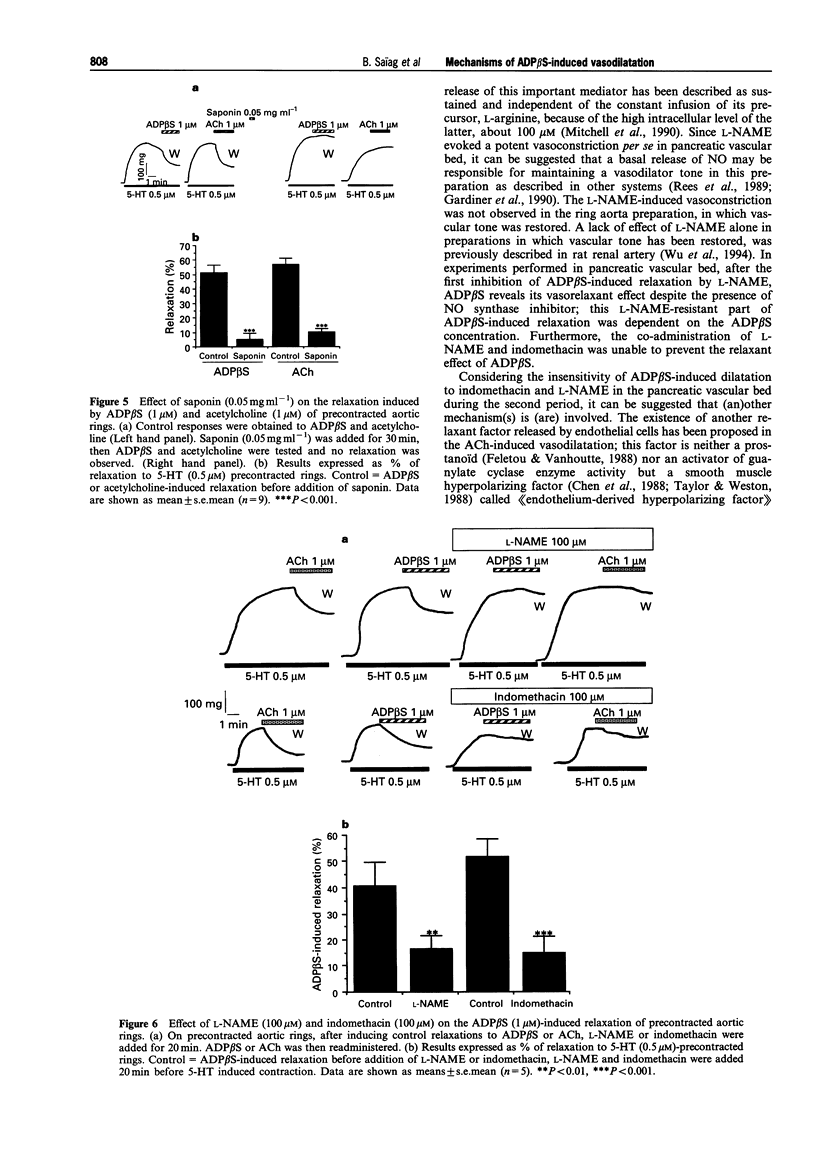
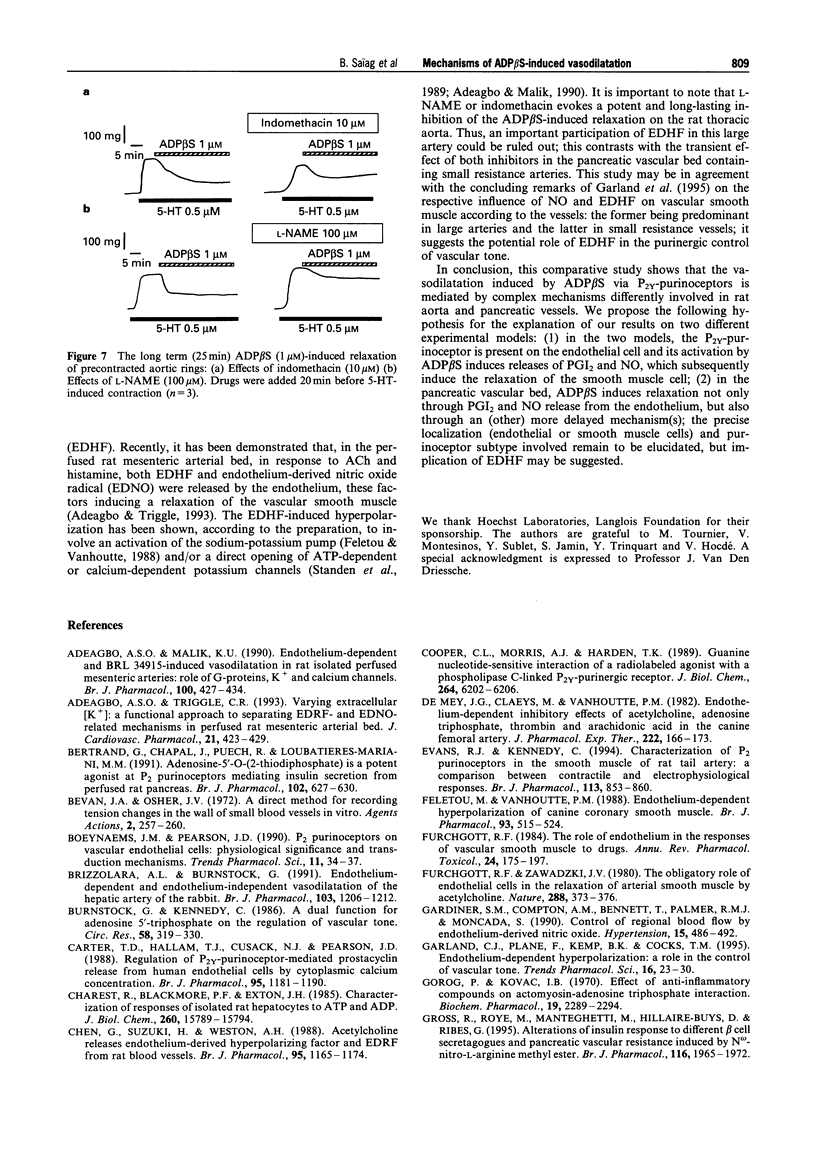
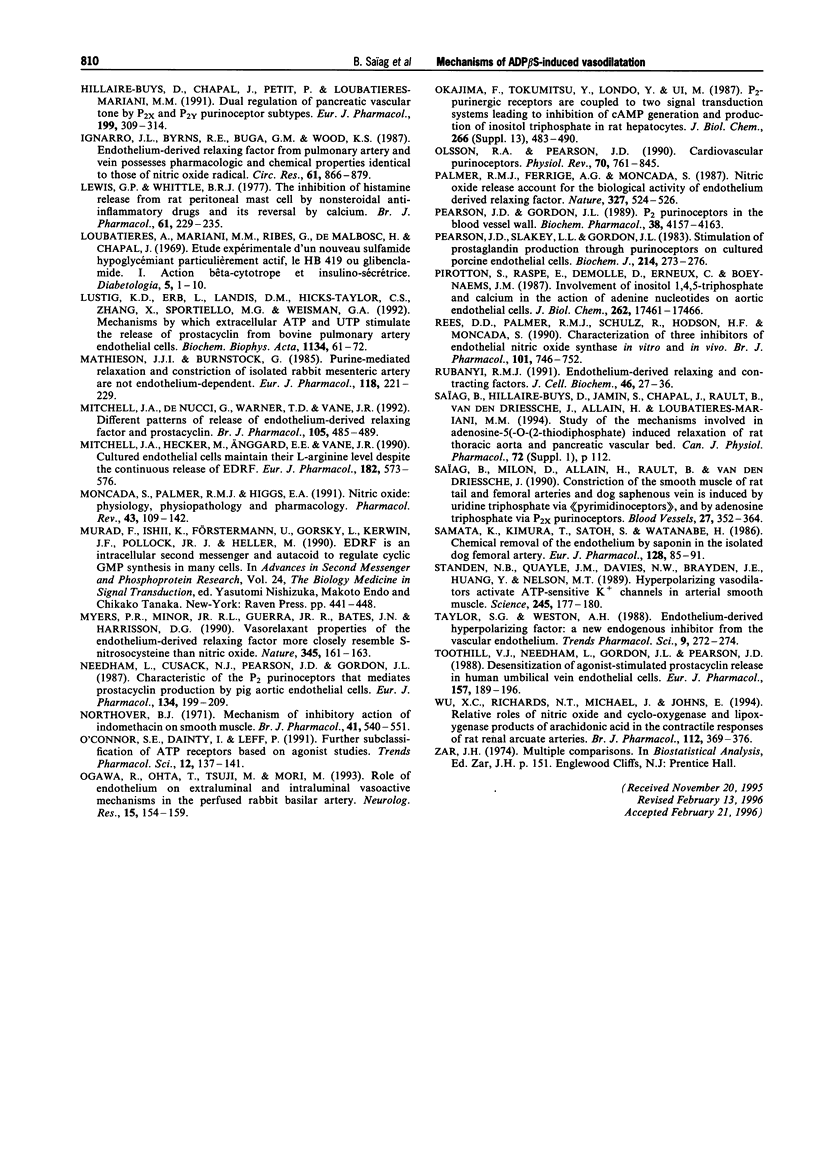
Selected References
These references are in PubMed. This may not be the complete list of references from this article.
- Adeagbo A. S., Malik K. U. Endothelium-dependent and BRL 34915-induced vasodilatation in rat isolated perfused mesenteric arteries: role of G-proteins, K+ and calcium channels. Br J Pharmacol. 1990 Jul;100(3):427–434. doi: 10.1111/j.1476-5381.1990.tb15823.x. [DOI] [PMC free article] [PubMed] [Google Scholar]
- Adeagbo A. S., Triggle C. R. Varying extracellular [K+]: a functional approach to separating EDHF- and EDNO-related mechanisms in perfused rat mesenteric arterial bed. J Cardiovasc Pharmacol. 1993 Mar;21(3):423–429. [PubMed] [Google Scholar]
- Bertrand G., Chapal J., Puech R., Loubatières-Mariani M. M. Adenosine-5'-O-(2-thiodiphosphate) is a potent agonist at P2 purinoceptors mediating insulin secretion from perfused rat pancreas. Br J Pharmacol. 1991 Mar;102(3):627–630. doi: 10.1111/j.1476-5381.1991.tb12223.x. [DOI] [PMC free article] [PubMed] [Google Scholar]
- Bevan J. A., Osher J. V. A direct method for recording tension changes in the wall of small blood vessels in vitro. Agents Actions. 1972;2(5):257–260. doi: 10.1007/BF02087051. [DOI] [PubMed] [Google Scholar]
- Boeynaems J. M., Pearson J. D. P2 purinoceptors on vascular endothelial cells: physiological significance and transduction mechanisms. Trends Pharmacol Sci. 1990 Jan;11(1):34–37. doi: 10.1016/0165-6147(90)90039-b. [DOI] [PubMed] [Google Scholar]
- Brizzolara A. L., Burnstock G. Endothelium-dependent and endothelium-independent vasodilatation of the hepatic artery of the rabbit. Br J Pharmacol. 1991 May;103(1):1206–1212. doi: 10.1111/j.1476-5381.1991.tb12325.x. [DOI] [PMC free article] [PubMed] [Google Scholar]
- Burnstock G., Kennedy C. A dual function for adenosine 5'-triphosphate in the regulation of vascular tone. Excitatory cotransmitter with noradrenaline from perivascular nerves and locally released inhibitory intravascular agent. Circ Res. 1986 Mar;58(3):319–330. doi: 10.1161/01.res.58.3.319. [DOI] [PubMed] [Google Scholar]
- Carter T. D., Hallam T. J., Cusack N. J., Pearson J. D. Regulation of P2y-purinoceptor-mediated prostacyclin release from human endothelial cells by cytoplasmic calcium concentration. Br J Pharmacol. 1988 Dec;95(4):1181–1190. doi: 10.1111/j.1476-5381.1988.tb11754.x. [DOI] [PMC free article] [PubMed] [Google Scholar]
- Charest R., Blackmore P. F., Exton J. H. Characterization of responses of isolated rat hepatocytes to ATP and ADP. J Biol Chem. 1985 Dec 15;260(29):15789–15794. [PubMed] [Google Scholar]
- Chen G., Suzuki H., Weston A. H. Acetylcholine releases endothelium-derived hyperpolarizing factor and EDRF from rat blood vessels. Br J Pharmacol. 1988 Dec;95(4):1165–1174. doi: 10.1111/j.1476-5381.1988.tb11752.x. [DOI] [PMC free article] [PubMed] [Google Scholar]
- Cooper C. L., Morris A. J., Harden T. K. Guanine nucleotide-sensitive interaction of a radiolabeled agonist with a phospholipase C-linked P2y-purinergic receptor. J Biol Chem. 1989 Apr 15;264(11):6202–6206. [PubMed] [Google Scholar]
- De Mey J. G., Claeys M., Vanhoutte P. M. Endothelium-dependent inhibitory effects of acetylcholine, adenosine triphosphate, thrombin and arachidonic acid in the canine femoral artery. J Pharmacol Exp Ther. 1982 Jul;222(1):166–173. [PubMed] [Google Scholar]
- Evans R. J., Kennedy C. Characterization of P2-purinoceptors in the smooth muscle of the rat tail artery: a comparison between contractile and electrophysiological responses. Br J Pharmacol. 1994 Nov;113(3):853–860. doi: 10.1111/j.1476-5381.1994.tb17071.x. [DOI] [PMC free article] [PubMed] [Google Scholar]
- Feletou M., Vanhoutte P. M. Endothelium-dependent hyperpolarization of canine coronary smooth muscle. Br J Pharmacol. 1988 Mar;93(3):515–524. doi: 10.1111/j.1476-5381.1988.tb10306.x. [DOI] [PMC free article] [PubMed] [Google Scholar]
- Furchgott R. F. The role of endothelium in the responses of vascular smooth muscle to drugs. Annu Rev Pharmacol Toxicol. 1984;24:175–197. doi: 10.1146/annurev.pa.24.040184.001135. [DOI] [PubMed] [Google Scholar]
- Furchgott R. F., Zawadzki J. V. The obligatory role of endothelial cells in the relaxation of arterial smooth muscle by acetylcholine. Nature. 1980 Nov 27;288(5789):373–376. doi: 10.1038/288373a0. [DOI] [PubMed] [Google Scholar]
- Gardiner S. M., Compton A. M., Bennett T., Palmer R. M., Moncada S. Control of regional blood flow by endothelium-derived nitric oxide. Hypertension. 1990 May;15(5):486–492. doi: 10.1161/01.hyp.15.5.486. [DOI] [PubMed] [Google Scholar]
- Garland C. J., Plane F., Kemp B. K., Cocks T. M. Endothelium-dependent hyperpolarization: a role in the control of vascular tone. Trends Pharmacol Sci. 1995 Jan;16(1):23–30. doi: 10.1016/s0165-6147(00)88969-5. [DOI] [PubMed] [Google Scholar]
- Gross R., Roye M., Manteghetti M., Hillaire-Buys D., Ribes G. Alterations of insulin response to different beta cell secretagogues and pancreatic vascular resistance induced by N omega-nitro-L-arginine methyl ester. Br J Pharmacol. 1995 Oct;116(3):1965–1972. doi: 10.1111/j.1476-5381.1995.tb16399.x. [DOI] [PMC free article] [PubMed] [Google Scholar]
- Görög P., Kovàcs I. B. Effect of anti-inflammatory compounds on actomyosin-adenosinetriphosphate interaction. Biochem Pharmacol. 1970 Jul;19(7):2289–2294. doi: 10.1016/0006-2952(70)90127-9. [DOI] [PubMed] [Google Scholar]
- Hillaire-Buys D., Chapal J., Petit P., Loubatières-Mariani M. M. Dual regulation of pancreatic vascular tone by P2X and P2Y purinoceptor subtypes. Eur J Pharmacol. 1991 Jul 9;199(3):309–314. doi: 10.1016/0014-2999(91)90494-b. [DOI] [PubMed] [Google Scholar]
- Ignarro L. J., Byrns R. E., Buga G. M., Wood K. S. Endothelium-derived relaxing factor from pulmonary artery and vein possesses pharmacologic and chemical properties identical to those of nitric oxide radical. Circ Res. 1987 Dec;61(6):866–879. doi: 10.1161/01.res.61.6.866. [DOI] [PubMed] [Google Scholar]
- Lewis G. P., Whittle B. J. The inhibition of histamine release from rat peritoneal mast cells by non-steroid anti-inflammatory drugs and its reversal by calcium. Br J Pharmacol. 1977 Oct;61(2):229–235. doi: 10.1111/j.1476-5381.1977.tb08409.x. [DOI] [PMC free article] [PubMed] [Google Scholar]
- Loubatières A., Mariani M. M., Ribes G., de Malbosc H., Chapal J. Etude expérimentale d'un nouveau sulfamide hypoglycémiant particulièrement actif, le HB 419 ou glibenclamide. Diabetologia. 1969 Feb;5(1):1–10. doi: 10.1007/BF01212212. [DOI] [PubMed] [Google Scholar]
- Lustig K. D., Erb L., Landis D. M., Hicks-Taylor C. S., Zhang X., Sportiello M. G., Weisman G. A. Mechanisms by which extracellular ATP and UTP stimulate the release of prostacyclin from bovine pulmonary artery endothelial cells. Biochim Biophys Acta. 1992 Feb 19;1134(1):61–72. doi: 10.1016/0167-4889(92)90028-a. [DOI] [PubMed] [Google Scholar]
- Mathieson J. J., Burnstock G. Purine-mediated relaxation and constriction of isolated rabbit mesenteric artery are not endothelium-dependent. Eur J Pharmacol. 1985 Dec 3;118(3):221–229. doi: 10.1016/0014-2999(85)90132-3. [DOI] [PubMed] [Google Scholar]
- Mitchell J. A., Hecker M., Anggård E. E., Vane J. R. Cultured endothelial cells maintain their L-arginine level despite the continuous release of EDRF. Eur J Pharmacol. 1990 Jul 17;182(3):573–576. doi: 10.1016/0014-2999(90)90058-e. [DOI] [PubMed] [Google Scholar]
- Mitchell J. A., de Nucci G., Warner T. D., Vane J. R. Different patterns of release of endothelium-derived relaxing factor and prostacyclin. Br J Pharmacol. 1992 Feb;105(2):485–489. doi: 10.1111/j.1476-5381.1992.tb14280.x. [DOI] [PMC free article] [PubMed] [Google Scholar]
- Moncada S., Palmer R. M., Higgs E. A. Nitric oxide: physiology, pathophysiology, and pharmacology. Pharmacol Rev. 1991 Jun;43(2):109–142. [PubMed] [Google Scholar]
- Murad F., Ishii K., Förstermann U., Gorsky L., Kerwin J. F., Jr, Pollock J., Heller M. EDRF is an intracellular second messenger and autacoid to regulate cyclic GMP synthesis in many cells. Adv Second Messenger Phosphoprotein Res. 1990;24:441–448. [PubMed] [Google Scholar]
- Myers P. R., Minor R. L., Jr, Guerra R., Jr, Bates J. N., Harrison D. G. Vasorelaxant properties of the endothelium-derived relaxing factor more closely resemble S-nitrosocysteine than nitric oxide. Nature. 1990 May 10;345(6271):161–163. doi: 10.1038/345161a0. [DOI] [PubMed] [Google Scholar]
- Needham L., Cusack N. J., Pearson J. D., Gordon J. L. Characteristics of the P2 purinoceptor that mediates prostacyclin production by pig aortic endothelial cells. Eur J Pharmacol. 1987 Feb 10;134(2):199–209. doi: 10.1016/0014-2999(87)90166-x. [DOI] [PubMed] [Google Scholar]
- Northover B. J. Mechanism of the inhibitory action of indomethacin on smooth muscle. Br J Pharmacol. 1971 Mar;41(3):540–551. doi: 10.1111/j.1476-5381.1971.tb08052.x. [DOI] [PMC free article] [PubMed] [Google Scholar]
- O'Connor S. E., Dainty I. A., Leff P. Further subclassification of ATP receptors based on agonist studies. Trends Pharmacol Sci. 1991 Apr;12(4):137–141. doi: 10.1016/0165-6147(91)90530-6. [DOI] [PubMed] [Google Scholar]
- Ogawa R., Ohta T., Tsuji M., Mori M. Role of the endothelium on extraluminal and intraluminal vasoactive mechanisms in the perfused rabbit basilar artery. Neurol Res. 1993 Jun;15(3):154–159. doi: 10.1080/01616412.1993.11740128. [DOI] [PubMed] [Google Scholar]
- Olsson R. A., Pearson J. D. Cardiovascular purinoceptors. Physiol Rev. 1990 Jul;70(3):761–845. doi: 10.1152/physrev.1990.70.3.761. [DOI] [PubMed] [Google Scholar]
- Palmer R. M., Ferrige A. G., Moncada S. Nitric oxide release accounts for the biological activity of endothelium-derived relaxing factor. Nature. 1987 Jun 11;327(6122):524–526. doi: 10.1038/327524a0. [DOI] [PubMed] [Google Scholar]
- Pearson J. D., Gordon J. L. P2 purinoceptors in the blood vessel wall. Biochem Pharmacol. 1989 Dec 1;38(23):4157–4163. doi: 10.1016/0006-2952(89)90509-1. [DOI] [PubMed] [Google Scholar]
- Pearson J. D., Slakey L. L., Gordon J. L. Stimulation of prostaglandin production through purinoceptors on cultured porcine endothelial cells. Biochem J. 1983 Jul 15;214(1):273–276. doi: 10.1042/bj2140273. [DOI] [PMC free article] [PubMed] [Google Scholar]
- Pirotton S., Raspe E., Demolle D., Erneux C., Boeynaems J. M. Involvement of inositol 1,4,5-trisphosphate and calcium in the action of adenine nucleotides on aortic endothelial cells. J Biol Chem. 1987 Dec 25;262(36):17461–17466. [PubMed] [Google Scholar]
- Rees D. D., Palmer R. M., Schulz R., Hodson H. F., Moncada S. Characterization of three inhibitors of endothelial nitric oxide synthase in vitro and in vivo. Br J Pharmacol. 1990 Nov;101(3):746–752. doi: 10.1111/j.1476-5381.1990.tb14151.x. [DOI] [PMC free article] [PubMed] [Google Scholar]
- Rubanyi G. M. Endothelium-derived relaxing and contracting factors. J Cell Biochem. 1991 May;46(1):27–36. doi: 10.1002/jcb.240460106. [DOI] [PubMed] [Google Scholar]
- Samata K., Kimura T., Satoh S., Watanabe H. Chemical removal of the endothelium by saponin in the isolated dog femoral artery. Eur J Pharmacol. 1986 Aug 22;128(1-2):85–91. doi: 10.1016/0014-2999(86)90561-3. [DOI] [PubMed] [Google Scholar]
- Saïag B., Milon D., Allaín H., Rault B., Van den Driessche J. Constriction of the smooth muscle of rat tail and femoral arteries and dog saphenous vein is induced by uridine triphosphate via 'pyrimidinoceptors', and by adenosine triphosphate via P2x purinoceptors. Blood Vessels. 1990;27(6):352–364. doi: 10.1159/000158829. [DOI] [PubMed] [Google Scholar]
- Standen N. B., Quayle J. M., Davies N. W., Brayden J. E., Huang Y., Nelson M. T. Hyperpolarizing vasodilators activate ATP-sensitive K+ channels in arterial smooth muscle. Science. 1989 Jul 14;245(4914):177–180. doi: 10.1126/science.2501869. [DOI] [PubMed] [Google Scholar]
- Taylor S. G., Weston A. H. Endothelium-derived hyperpolarizing factor: a new endogenous inhibitor from the vascular endothelium. Trends Pharmacol Sci. 1988 Aug;9(8):272–274. doi: 10.1016/0165-6147(88)90003-x. [DOI] [PubMed] [Google Scholar]
- Toothill V. J., Needham L., Gordon J. L., Pearson J. D. Desensitization of agonist-stimulated prostacyclin release in human umbilical vein endothelial cells. Eur J Pharmacol. 1988 Nov 22;157(2-3):189–196. doi: 10.1016/0014-2999(88)90382-2. [DOI] [PubMed] [Google Scholar]
- Wu X. C., Richards N. T., Michael J., Johns E. Relative roles of nitric oxide and cyclo-oxygenase and lipoxygenase products of arachidonic acid in the contractile responses of rat renal arcuate arteries. Br J Pharmacol. 1994 Jun;112(2):369–376. doi: 10.1111/j.1476-5381.1994.tb13081.x. [DOI] [PMC free article] [PubMed] [Google Scholar]


